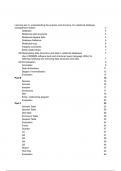Essay
Distiction Unit 2- Creating Systems to Manage Information
- Course
- Institution
Distinction Level BTEC Unit 2 - Creating Systems to Manage Information Unit 2 focuses on the practical skills and theoretical knowledge required to design, develop, and implement effective database systems to manage information. This unit is essential for students to understand how databases are...
[Show more]



